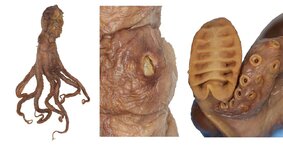- Joined
- Nov 19, 2002
- Messages
- 4,674
It's been quite some time since I've posted here, but I've found myself with something a little odd and I could sure do with some input from others regarding its identity. If anyone can shed any light on this/has any suggestions as to an appropriate genus to accommodate it in (there are no genetic data), or has seen anything like it before, I'd sure appreciate hearing from them.
Basically we have a large, deep-sea octopus. It has a name. It was described over a century ago, and there are a number of specimens of it, male and female, all of which are in very good condition (quite remarkable for its age), all of which are basically identical (so we are not dealing with anything that might be deemed 'aberrant'). Subsequent to its original description this species has been seldom referred to; I do not believe the specimens have ever been figured. The species is currently considered a synonym of something else, but I question this synonymy.
I do not want to provide its name, or author, or too much information to give its identity away, because that's not the problem I have. My questions are: what genus is appropriate to attribute this (named) species to, based on the following (deliberately brief) diagnosis, and second, and probably most important of all, has anyone seen anything quite like this before? If you have I would dearly love to hear from you, and all about the specimens.
'Diagnosis'
The following combination of characters/states apply to this species: large size (> 400mm TL, ML > ~ 80 mm), long arms, very high total arm sucker count (>200/arm), papillose dorsum (especially on the dorsal surfaces around the eye), and a typical Bathypolypus-style calamus.
A number of existing generic names might be available to accommodate this species, not limited to: Bathypolypus, Benthoctopus, Atlantoctopus, Teretoctopus, Muusoctopus, Sasakiopus, and Vulcanoctopus. I have previously mentioned that it has a typical 'Bathypolypus' hectocotylus. It is important that you disregard what I have said about 'typical,' and that you disregard the current systematic status of each of the aforementioned genera (e.g., both Benthoctopus and Atlantoctopus are currently considered to be synonyms of Bathypolypus, with most species formerly attributed to Benthoctopus now referred to Muusoctopus; Vulcanoctopus has been considered a junior synonym of Muusoctopus, but the opposite is actually true; Teretoctopus has not been described subsequent to its original description and nobody really knows what it is).
Basically we have a large, deep-sea octopus. It has a name. It was described over a century ago, and there are a number of specimens of it, male and female, all of which are in very good condition (quite remarkable for its age), all of which are basically identical (so we are not dealing with anything that might be deemed 'aberrant'). Subsequent to its original description this species has been seldom referred to; I do not believe the specimens have ever been figured. The species is currently considered a synonym of something else, but I question this synonymy.
I do not want to provide its name, or author, or too much information to give its identity away, because that's not the problem I have. My questions are: what genus is appropriate to attribute this (named) species to, based on the following (deliberately brief) diagnosis, and second, and probably most important of all, has anyone seen anything quite like this before? If you have I would dearly love to hear from you, and all about the specimens.
'Diagnosis'
The following combination of characters/states apply to this species: large size (> 400mm TL, ML > ~ 80 mm), long arms, very high total arm sucker count (>200/arm), papillose dorsum (especially on the dorsal surfaces around the eye), and a typical Bathypolypus-style calamus.
A number of existing generic names might be available to accommodate this species, not limited to: Bathypolypus, Benthoctopus, Atlantoctopus, Teretoctopus, Muusoctopus, Sasakiopus, and Vulcanoctopus. I have previously mentioned that it has a typical 'Bathypolypus' hectocotylus. It is important that you disregard what I have said about 'typical,' and that you disregard the current systematic status of each of the aforementioned genera (e.g., both Benthoctopus and Atlantoctopus are currently considered to be synonyms of Bathypolypus, with most species formerly attributed to Benthoctopus now referred to Muusoctopus; Vulcanoctopus has been considered a junior synonym of Muusoctopus, but the opposite is actually true; Teretoctopus has not been described subsequent to its original description and nobody really knows what it is).

